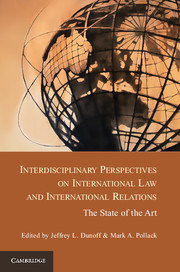 Interdisciplinary Perspectives on International Law and International Relations
Interdisciplinary Perspectives on International Law and International Relations Book contents
- Frontmatter
- Contents
- Contributors
- Acknowledgments
- Part I Introduction: Setting the Stage
- Part II Theorizing International Law
- Part III Making International Law
- Part IV The Interpretation and Application of International Law
- Part V Enforcement, Compliance, and Effectiveness
- 19 The Engines of Compliance
- 20 Coercive Enforcement of International Law
- 21 Reputation in International Relations and International Law Theory
- 22 Open Economy Law
- 23 Persuading to Comply
- 24 Against Compliance
- Conclusions
- Index
- References
20 - Coercive Enforcement of International Law
Published online by Cambridge University Press: 05 January 2013
- Frontmatter
- Contents
- Contributors
- Acknowledgments
- Part I Introduction: Setting the Stage
- Part II Theorizing International Law
- Part III Making International Law
- Part IV The Interpretation and Application of International Law
- Part V Enforcement, Compliance, and Effectiveness
- 19 The Engines of Compliance
- 20 Coercive Enforcement of International Law
- 21 Reputation in International Relations and International Law Theory
- 22 Open Economy Law
- 23 Persuading to Comply
- 24 Against Compliance
- Conclusions
- Index
- References
Summary
Questions surrounding the enforcement of international legal rules – whether it exists, how it operates, and how effective it is – have implications for important debates in the fields of international law (IL) and international relations (IR). Legal theorists have pondered for centuries whether the existence of robust enforcement is a necessary condition for international law to be considered “law” in a meaningful sense. Skeptics in both fields argue that the lack of a centralized enforcement mechanism renders international law epiphenomenal to state interests and relative power considerations (Mearsheimer 2001; Goldsmith and Posner 2005). This critique has been applied most vehemently to the use of force: critics claim that it is not adequately regulated by international law, or worse, that military interventions are often conducted for political reasons but in the guise of legal enforcement (Hoffmann 1961; Glennon 2001).
Scholars with a more expansive appreciation for international law point to a wider range of incentives to comply, both internal and external to the state, but most nevertheless recognize the importance of enforcement in some form. Although Louis Henkin argues that states are motivated by a “culture of compliance” with international law, he also recognizes that “external inducements” – retaliation and sanctions by other states – play a crucial role in promoting compliant behavior (Henkin 1995: 50–51). Mary Ellen O’Connell is equally optimistic about compliance but nevertheless stresses the value of enforcement: “So long as sanctions exist and support widespread law compliance, international law is a legal system worthy of the name” (2008: 369). Because the stakes are so high, theoretically and in the real world of international affairs, it is important to develop an accurate sense of how enforcement operates and how it relates to compliance behavior.
- Type
- Chapter
- Information
- Interdisciplinary Perspectives on International Law and International RelationsThe State of the Art, pp. 502 - 523Publisher: Cambridge University PressPrint publication year: 2012
References
- 3
- Cited by


